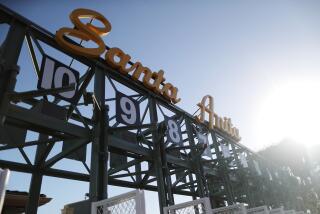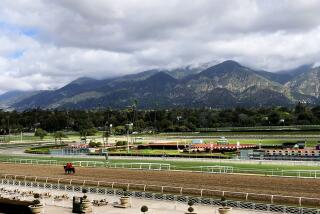Miniature Horses, Carts Help Drive Ranch : Hobby: Small equines and downsized buggies are the passions of husband-wife managers of a 270-acre citrus farm.
- Share via
SANTA ROSA VALLEY — Don’t ignore the traffic sign emblazoned with a horse and carriage on the main road to the ranch Michael Parker manages.
Otherwise, you might run into 3-foot-high horses clattering over the roads as they pull small-scale carriages and carts around the working citrus farm in the Santa Rosa Valley.
The miniature horses and carriages are the passions of Michael and Laurin Parker, who live on a 270-acre tract that was part of the original ranch owned by the Camarillo family.
Michael Parker--great-grandson of Adolfo Camarillo--runs a business handcrafting small-scale carriages for use with miniature horses. He also renovates full-sized vehicles for customers nationwide in addition to helping manage the avocado and lemon ranch.
His wife, Laurin, owns 17 miniature horses that she breeds and trains for driving competitions--which include events such as the timed maneuvering of an obstacle course.
“It’s really satisfying to have common interests,” said Michael, 35.
“If Michael were born during the Renaissance, he would have been an artisan. That’s why he’s been able to build me all this stuff,” said Laurin, 42.
Michael Parker, who formerly managed an 1,800-acre cattle ranch in Montana, is a master at making small-scale models of carriages used in the 19th Century.
Hand-carving wooden pieces and forging steel and brass parts, he painstakingly reproduces everything from road carts to hitch wagons to formal carriages.
Sometimes he has little to go on but his eye for detail. He modeled a ladies driving phaeton, circa 1890, from a sketch in a book. He drew a design, judging the size by standing one of the small horses next to it. He figured leg distance by having Laurin lie next to the drawing of the design.
His most popular model is an $1,800 road cart based on those once used by people traveling through the countryside to visit neighbors. The one-horse cart of brass and wood is specially designed to distribute weight from the vehicle and driver and minimize pressure on the horse.
Also, Michael’s wooden-wheeled carts and carriages make it seem that adults driving the horses are smaller so they do not dwarf the animals. Miniature horses, which weigh 175 to 200 pounds, measure no more than 34 inches from hoofs to shoulders.
He relies primarily on word of mouth to advertise his business, and is helped in that effort when his wife competes in the vehicles.
Indeed, it was Laurin who implored her husband to design his first cart and carriage for miniature horses after she became interested in the sport in 1987 and decided that she didn’t want to use the bicycle-wheeled vehicles on the market.
Laurin had competed with full-sized horses in dressage for years and went on to judge the event. She bought her first miniature horse simply because she wanted a companion for her miniature pet donkey.
But she became intrigued with the breed and later trained the horse to pull a cart she drove, earning top honors in one of the first competitions she entered.
Interest in the sport led to the accumulation of what she now describes as more than $100,000 in miniatures--the numerous equines who graze around the couple’s ranch house, peering in the living room windows. She said she expects them to work like horses, not just be pets. But she says their dispositions are sweet.
“If you want to train these, it’s just like playing with puppies,” she said, picking up the front legs of a horse and nuzzling its forehead.
She has won 11 national titles competing with the small horses since 1988. She has also appeared for the past two years in the Rose Parade and three times in the Fiesta Parade held each August in Santa Barbara.
Michael also refurbishes full-size carriages, which might have been sitting in the family garage for decades. Most customers want to fix up the carriages for pleasure driving or for showing in competitions.
He restores the wood, sometimes duplicating the hand-carved vehicles piece by piece. The typical restoration takes 200 to 400 hours, with price depending on the condition of the vehicle, he said.
Michael Parker first restored a carriage 15 years ago when his mother said she wanted to drive a surrey that had been used by the family about 60 years earlier.
He said he began the project with no particular training, although he had a background in carpentry and welding. The results met with approval from his late great-aunt, Carmen Camarillo Jones, who had ridden in the vehicle as a child.
“My great-aunt was still alive and she rode in it,” Parker said. “She said, ‘This is sure neat.’ ”
More to Read
Sign up for The Wild
We’ll help you find the best places to hike, bike and run, as well as the perfect silent spots for meditation and yoga.
You may occasionally receive promotional content from the Los Angeles Times.






